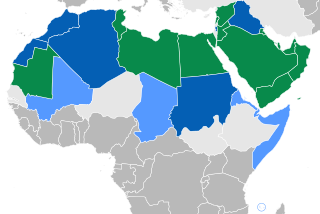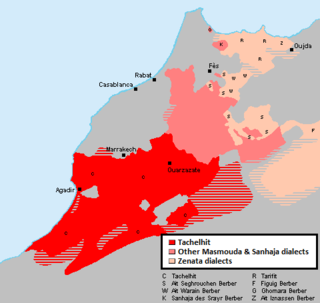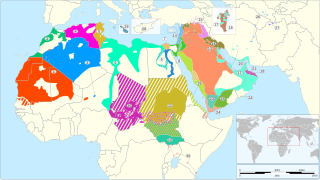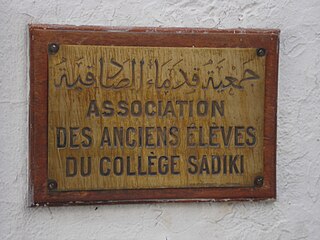
Arabic is a Central Semitic language of the Afroasiatic language family spoken primarily in the Arab world. The ISO assigns language codes to 32 varieties of Arabic, including its standard form of Literary Arabic, known as Modern Standard Arabic, which is derived from Classical Arabic. This distinction exists primarily among Western linguists; Arabic speakers themselves generally do not distinguish between Modern Standard Arabic and Classical Arabic, but rather refer to both as al-ʿarabiyyatu l-fuṣḥā or simply al-fuṣḥā (اَلْفُصْحَىٰ).
Modern Hebrew has 25 to 27 consonants and 5 to 10 vowels, depending on the speaker and the analysis.
In phonetics, rhotic consonants, or "R-like" sounds, are liquid consonants that are traditionally represented orthographically by symbols derived from the Greek letter rho, including ⟨R⟩, ⟨r⟩ in the Latin script and ⟨Р⟩, ⟨p⟩ in the Cyrillic script. They are transcribed in the International Phonetic Alphabet by upper- or lower-case variants of Roman ⟨R⟩, ⟨r⟩: ⟨r⟩, ⟨ɾ⟩, ⟨ɹ⟩, ⟨ɻ⟩, ⟨ʀ⟩, ⟨ʁ⟩, ⟨ɽ⟩, and ⟨ɺ⟩. Transcriptions for vocalic or semivocalic realisations of underlying rhotics include the ⟨ə̯⟩ and ⟨ɐ̯⟩.

The Tuareg languages constitute a group of closely related Berber languages and dialects. They are spoken by the Tuareg Berbers in large parts of Mali, Niger, Algeria, Libya and Burkina Faso, with a few speakers, the Kinnin, in Chad.
Uvulars are consonants articulated with the back of the tongue against or near the uvula, that is, further back in the mouth than velar consonants. Uvulars may be stops, fricatives, nasals, trills, or approximants, though the IPA does not provide a separate symbol for the approximant, and the symbol for the voiced fricative is used instead. Uvular affricates can certainly be made but are rare: they occur in some southern High-German dialects, as well as in a few African and Native American languages. Uvular consonants are typically incompatible with advanced tongue root, and they often cause retraction of neighboring vowels.
Guttural speech sounds are those with a primary place of articulation near the back of the oral cavity, where it is difficult to distinguish a sound's place of articulation and its phonation. In popular usage it is an imprecise term for sounds produced relatively far back in the vocal tract, such as the German ch or the Arabic ayin, but not simple glottal sounds like h. The term 'guttural language' is used for languages that have such sounds.

Pharyngealization is a secondary articulation of consonants or vowels by which the pharynx or epiglottis is constricted during the articulation of the sound.

The voiceless pharyngeal fricative is a type of consonantal sound, used in some spoken languages. The symbol in the International Phonetic Alphabet that represents this sound is an h-bar, ⟨ħ⟩, and the equivalent X-SAMPA symbol is X\. In the transcription of Arabic, Berber as well as a few other scripts, it is often written ⟨Ḥ⟩, ⟨ḥ⟩.

A pharyngeal consonant is a consonant that is articulated primarily in the pharynx. Some phoneticians distinguish upper pharyngeal consonants, or "high" pharyngeals, pronounced by retracting the root of the tongue in the mid to upper pharynx, from (ary)epiglottal consonants, or "low" pharyngeals, which are articulated with the aryepiglottic folds against the epiglottis at the entrance of the larynx, as well as from epiglotto-pharyngeal consonants, with both movements being combined.
Gǀui or Gǀwi is a Khoe dialect of Botswana with 2,500 speakers. It is part of the Gǁana dialect cluster, and is closely related to Naro. It has a number of loan words from ǂʼAmkoe. Gǀui, ǂʼAmkoe, and Taa form the core of the Kalahari Basin sprachbund, and share a number of characteristic features, including extremely large consonant inventories.

Shilha, now more commonly known as Tashelhiyt, Tachelhit, is a Berber language spoken in southwestern Morocco. When referring to the language, anthropologists and historians prefer the name Shilha, which is in the Oxford English Dictionary (OED). Linguists writing in English prefer Tashelhit. In French sources the language is called tachelhit, chelha or chleuh.
While many languages have numerous dialects that differ in phonology, the contemporary spoken Arabic language is more properly described as a continuum of varieties. This article deals primarily with Modern Standard Arabic (MSA), which is the standard variety shared by educated speakers throughout Arabic-speaking regions. MSA is used in writing in formal print media and orally in newscasts, speeches and formal declarations of numerous types.

Tarifit Berber, also known as Riffian or locally as Tamazight is a Zenati Berber language spoken in the Rif region in northern Morocco. It is spoken natively by some 1,271,000 Rifians primarily in the Rif provinces of Al Hoceima, Nador and Driouch. Tarifit is strongly influenced by the Arabic language, and borrowed foreign loanwords represent 51.7% of the total Tarifit vocabulary.

Tunisian Arabic, or simply Tunisian, is a variety of Arabic spoken in Tunisia. It is known among its 12 million speakers as Tūnsi, "Tunisian" or Derja to distinguish it from Modern Standard Arabic, the official language of Tunisia. Tunisian Arabic is mostly similar to eastern Algerian Arabic and western Libyan Arabic.
Doubly articulated consonants are consonants with two simultaneous primary places of articulation of the same manner. They are a subset of co-articulated consonants. They are to be distinguished from co-articulated consonants with secondary articulation; that is, a second articulation not of the same manner. An example of a doubly articulated consonant is the voiceless labial–velar plosive, which is a and a pronounced simultaneously. On the other hand, the voiceless labialized velar plosive has only a single stop articulation, velar, with a simultaneous approximant-like rounding of the lips. In some dialects of Arabic, the voiceless velar fricative has a simultaneous uvular trill, but this is not considered double articulation either.
Libyan Arabic, also called Sulaimitian Arabic by scholars, is a variety of Arabic spoken in Libya, and neighboring countries. It can be divided into two major dialect areas; the eastern centred in Benghazi and Bayda, and the western centred in Tripoli and Misrata. The Eastern variety extends beyond the borders to the east and share the same dialect with far Western Egypt, Western Egyptian Bedawi Arabic, with between 90,000 and 474,000 speakers in Egypt. A distinctive southern variety, centered on Sabha, also exists and is more akin to the western variety. Another Southern dialect is also shared along the borders with Niger with 12,900 speakers in Niger as of 2021.

Douiret is a ruined Berber village in the Tataouine district in southern Tunisia. Located on a hilltop near a modern village of the same name, Douiret was a fortified granary, or ksar Like other ksour created by North African Berber communities, Douiret was built on a hilltop to help protect it from raiding parties. Douiret is a regular stop on southern Tunisia's ksar trail, along with the villages of Chenini, Ksar Ouled Soltane and Ksar Hadada.

Central Atlas Tamazight or Atlasic is a Berber language of the Afroasiatic language family spoken by 3.1 million speakers.

Varieties of Arabic are the linguistic systems that Arabic speakers speak natively. Arabic is a Semitic language within the Afroasiatic family that originated in the Arabian Peninsula. There are considerable variations from region to region, with degrees of mutual intelligibility that are often related to geographical distance and some that are mutually unintelligible. Many aspects of the variability attested to in these modern variants can be found in the ancient Arabic dialects in the peninsula. Likewise, many of the features that characterize the various modern variants can be attributed to the original settler dialects as well as local native languages and dialects. Some organizations, such as SIL International, consider these approximately 30 different varieties to be separate languages, while others, such as the Library of Congress, consider them all to be dialects of Arabic.

Of the languages of Tunisia, Arabic is the sole official language according to the Tunisian Constitution.












